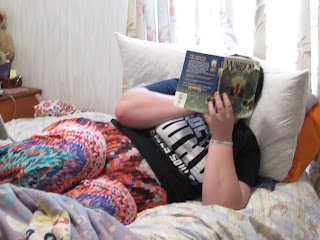Learning to Read
I did not teach my children how to read.
I read to my children from the time they were born until they sighed and rolled their eyes at me when I sat down to read with them...or until they insisted on reading to me. Often, as young children, they would sit in my lap, looking at the pictures and following my finger underlining the words as we read. For books without pictures, they would close their eyes, envisioning the story in their minds, and complain when I'd stop reading, thinking they had fallen asleep. They were just deep into the story's world, captivated by the scenes that unfolded as they listened.
My children also followed along with me in the book of worship on Sunday mornings. As we sang hymns, they would again follow my finger as I underlined the words. Hymnals are wonderful for learning to read, as most words are broken up, syllable by syllable.
Often, I'd hear, "what does that say" from the backseat of the car, from the child riding on my back as we took a walk, or while we were perusing a menu. Most times, I wouldn't ask the child to sound it out, I'd simply ask what letters were in the word to make sure I read the correct word to the child.
I spoke to my children as human beings, not as immature creatures who spoke a language called baby talk. I used big words and a normal tone of voice.
My husband and I would spell things when we didn't want our kids to know what we were talking about, as parents tend to do. Our children quickly caught on to the fact that i - c - e - c - r - e - a - m at F - r - i - e - n - d - l - y - 's was something very desirable, so other things we spelled must be as well. Once our oldest became a whiz at deciphering quickly spelled words, we started to have to use bigger words, rather than spelling words. For example, I once asked my husband if he wanted to venture forth with our progeny to the amicable eatery for frozen dairy delights.
Our oldest child started reading at age two and was reading fifth grade level books by age five. Our second child was an early (but not quite that early) reader as well. I admit to a bit of panic when our third child reached the ripe old age of six without an iota of desire to learn to read. However, by six and a half, she had her sights set on reading Little House on the Prairie by herself, and in six weeks went from "See Spot. See Spot run," to "Once upon a time, a little girl named Laura traveled in a covered wagon across the giant prairie." Our fourth child learned to read in order to play the Pokemon card game with his siblings when he was seven. Our fifth child swore she couldn't read, and then got caught by her grandparents telling them about what she had read on science center animal habitat description sign after previously making them read many of the signs to her. She was five.
As they grew older, they would grab a book and curl up on my bed with me, joining in the luxury of getting lost in a book.
My children were never forced to learn to read. They came about it quite organically, in their own time, and learned in their own way. We gave them a good foundation and were there for them when they needed assistance along the way. They all love to read, making a beeline to the book section of the thrift store upon entering, no matter their mother's plans for the shopping trip. To them, books are beloved friends, things to be treasured. And I love it that, when given the choice, they would rather hold a physical book in their hands than read it on a device...so they can have what they consider the full reading experience.
I didn't teach my children to read. I modeled for them and encouraged in them a love of reading.



Comments
Post a Comment